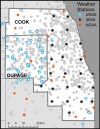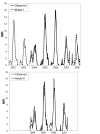Local impact of temperature and precipitation on West Nile virus infection in Culex species mosquitoes in northeast Illinois, USA
- PMID: 20302617
- PMCID: PMC2856545
- DOI: 10.1186/1756-3305-3-19
Local impact of temperature and precipitation on West Nile virus infection in Culex species mosquitoes in northeast Illinois, USA
Abstract
Background: Models of the effects of environmental factors on West Nile virus disease risk have yielded conflicting outcomes. The role of precipitation has been especially difficult to discern from existing studies, due in part to habitat and behavior characteristics of specific vector species and because of differences in the temporal and spatial scales of the published studies. We used spatial and statistical modeling techniques to analyze and forecast fine scale spatial (2000 m grid) and temporal (weekly) patterns of West Nile virus mosquito infection relative to changing weather conditions in the urban landscape of the greater Chicago, Illinois, region for the years from 2004 to 2008.
Results: Increased air temperature was the strongest temporal predictor of increased infection in Culex pipiens and Culex restuans mosquitoes, with cumulative high temperature differences being a key factor distinguishing years with higher mosquito infection and higher human illness rates from those with lower rates. Drier conditions in the spring followed by wetter conditions just prior to an increase in infection were factors in some but not all years. Overall, 80% of the weekly variation in mosquito infection was explained by prior weather conditions. Spatially, lower precipitation was the most important variable predicting stronger mosquito infection; precipitation and temperature alone could explain the pattern of spatial variability better than could other environmental variables (79% explained in the best model). Variables related to impervious surfaces and elevation differences were of modest importance in the spatial model.
Conclusion: Finely grained temporal and spatial patterns of precipitation and air temperature have a consistent and significant impact on the timing and location of increased mosquito infection in the northeastern Illinois study area. The use of local weather data at multiple monitoring locations and the integration of mosquito infection data from numerous sources across several years are important to the strength of the models presented. The other spatial environmental factors that tended to be important, including impervious surfaces and elevation measures, would mediate the effect of rainfall on soils and in urban catch basins. Changes in weather patterns with global climate change make it especially important to improve our ability to predict how inter-related local weather and environmental factors affect vectors and vector-borne disease risk.Local impact of temperature and precipitation on West Nile virus infection in Culex species mosquitoes in northeast Illinois, USA.
Figures






Similar articles
-
The drivers of West Nile virus human illness in the Chicago, Illinois, USA area: Fine scale dynamic effects of weather, mosquito infection, social, and biological conditions.PLoS One. 2020 May 21;15(5):e0227160. doi: 10.1371/journal.pone.0227160. eCollection 2020. PLoS One. 2020. PMID: 32437363 Free PMC article.
-
Predicting West Nile Virus Infection Risk From the Synergistic Effects of Rainfall and Temperature.J Med Entomol. 2016 Jul;53(4):935-944. doi: 10.1093/jme/tjw042. Epub 2016 Apr 25. J Med Entomol. 2016. PMID: 27113111
-
Terrestrial vegetation and aquatic chemistry influence larval mosquito abundance in catch basins, Chicago, USA.Parasit Vectors. 2013 Jan 11;6:9. doi: 10.1186/1756-3305-6-9. Parasit Vectors. 2013. PMID: 23311394 Free PMC article.
-
Short-term Forecasting of Daily Abundance of West Nile Virus Vectors Culex pipiens-restuans (Diptera: Culicidae) and Aedes vexans Based on Weather Conditions in Southern Québec (Canada).J Med Entomol. 2019 Apr 16;56(3):859-872. doi: 10.1093/jme/tjz002. J Med Entomol. 2019. PMID: 30753555
-
West Nile Virus Mosquito Vectors in North America.J Med Entomol. 2019 Oct 28;56(6):1475-1490. doi: 10.1093/jme/tjz146. J Med Entomol. 2019. PMID: 31549725 Review.
Cited by
-
Climate change, environment pollution, COVID-19 pandemic and mental health.Sci Total Environ. 2021 Jun 15;773:145182. doi: 10.1016/j.scitotenv.2021.145182. Epub 2021 Jan 21. Sci Total Environ. 2021. PMID: 33940721 Free PMC article. Review.
-
Spatial patterns of West Nile virus distribution in the Volgograd region of Russia, a territory with long-existing foci.PLoS Negl Trop Dis. 2022 Jan 31;16(1):e0010145. doi: 10.1371/journal.pntd.0010145. eCollection 2022 Jan. PLoS Negl Trop Dis. 2022. PMID: 35100289 Free PMC article.
-
Stochastic environmental fluctuations drive epidemiology in experimental host-parasite metapopulations.Proc Biol Sci. 2013 Aug 21;280(1769):20131747. doi: 10.1098/rspb.2013.1747. Print 2013 Oct 22. Proc Biol Sci. 2013. PMID: 23966645 Free PMC article.
-
Regional and seasonal response of a West Nile virus vector to climate change.Proc Natl Acad Sci U S A. 2013 Sep 24;110(39):15620-5. doi: 10.1073/pnas.1307135110. Epub 2013 Sep 9. Proc Natl Acad Sci U S A. 2013. PMID: 24019459 Free PMC article.
-
Infection risk varies within urbanized landscapes: the case of coyotes and heartworm.Parasit Vectors. 2021 Sep 9;14(1):464. doi: 10.1186/s13071-021-04958-1. Parasit Vectors. 2021. PMID: 34503566 Free PMC article.
References
-
- Platonov AE, Fedorova MV, Karan LS, Shopenskaya TA, Platonova OV, Zhuravlev VI. Epidemiology of West Nile infection in Volgograd, Russia, in relation to climate change and mosquito (Diptera: Culicidae) bionomics. Parasitology Research. 2008;103:S45–S53. doi: 10.1007/s00436-008-1050-0. - DOI - PubMed
LinkOut - more resources
Full Text Sources

